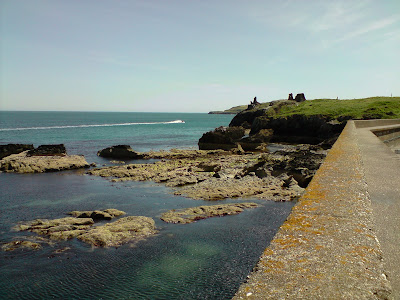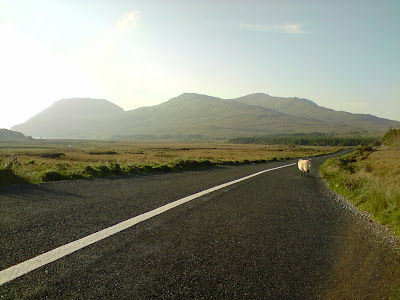See ya there :)
12.26.2009
Will continues in Wiwi In Ireland Canalblog :)
Oops, I'm not here anymore... but you can still follow me over here :
8.02.2009
Sea, sun and Ireland
Yes, I know, it's hard to believe, but it is in Ireland ! "The sea is just a wetter version of the sky" would say Regina Spektor, but here this is not true, most of the time. This is the reason why I took this picture, to prove that we can have a beautiful weather in Ireland as well... sometimes.
Labels:
county Wicklow,
miracle,
sea
Horses
Horses in Ireland are not very present, excepted in the Connemara National Park. However, nobody can say that they are unhappy up here, in the green Ireland ! This pic has been taken in the Devil's Glen Village, in the County Wicklow.
Labels:
animals,
county Wicklow,
horses
The Cliffs of Moher
Labels:
cliffs of Moher,
county Clare,
Galway,
travel
Connemara National Park - Sheeps story
 Small sheeps crossing roads in the Connemara National Park, so beautiful ! I have to say that there are pretty hard to shoot, because they are used to cars but not to people... so they don't move when the cars pass by, but they run away as soon as you get off of the car, clever !
Small sheeps crossing roads in the Connemara National Park, so beautiful ! I have to say that there are pretty hard to shoot, because they are used to cars but not to people... so they don't move when the cars pass by, but they run away as soon as you get off of the car, clever !
Labels:
animals,
connemara national park,
Galway,
Mayo county,
travel
Connemara National Park
Labels:
connemara national park,
Galway,
Mayo county,
travel
7.26.2009
Grave stones
Graves stones in Ireland, here in Clonmacnoise, county Offaly, are pretty impressive and massive. Most of the time, they are decorated with sculptures and the celtic Cross on the top. Some of them date from the early centuries and have seen their beauty fading through the time, others are burying little by little in the ground, giving to the cimeteries their exceptionnal authenticity.
Labels:
grave stones,
historic,
monument,
Offaly,
religious
Clonmacnoise
Located in the middle of Ireland on the Shannon side, Clonmacnoise is very known for its several churches and grave stones... in ruins. From the sixth century, this historic and religious site have seen so many wars, theft, and fires, that it is almost surpising that the is something left... even ruins. At that time, Clonmacnoise was famous for its religious instruction, with an impressive library. Pilgrims used to, and still use to walk until this monastery every year. The pope John Paul II came to Clonmacnoise during his journey throughout Ireland in 1979, gathering thousands of people.
Labels:
architecture,
historic,
monument,
Offaly,
religious
7.12.2009
The Custom House
The Custom House is an eighteenth-century building in Dublin which houses the Department of the Environment, Heritage and Local Government. It was designed by James Gandon to act as the new custom house for Dublin Port. It has been completed in 1791.
As the port moved further downriver, the building's original use became obsolete, and is now used as the headquarters of local government in Dublin.
As the port moved further downriver, the building's original use became obsolete, and is now used as the headquarters of local government in Dublin.
Labels:
architecture,
building,
Dublin,
historic
The Docklands
This new area of Dublin used to be the docks of the city. Today, the docks are more in the east, close to the Dublin's Bay, redesigned to fit with the big ferries and industrial boats. The Docklands is now in works, where a lot of buildings are growing up, with a brand new architecture. Hotels, appartments, squares, shopping centers, theatre and even a new bridge, this area is meant to be very posh in the future, with very expensive restaurants, shops and flats for some tens of thousands of euros...
Labels:
architecture,
docklands,
Dublin,
social life
The Maritime Festival
Once a year, in June, a large selection of tall ships visit the Dublin's main river, the Liffey, in the Docklands. I went to this festival last year, it is pretty impressive. There are some tens of tall ships, selected among the most beautiful tall ships in Europe, travelling town to town, gathering thousands of people. The best point is that you can really board the boats, and for free ! You can of course fill the "tip box" if you enjoyed the visit, in order to encourage its occupants. This festival is also the opportunity to discover (or rediscover) the food from other countries, like this very particular "grass shot" I drank this day... a "one in a life" opportunity !
Labels:
boat,
docklands,
Dublin,
festival,
Liffey River,
social event,
tall ship
Liberty Hall
Liberty Hall (Irish: Halla na Saoirse), in Dublin, is the headquarters of the Services, Industrial, Professional, and Technical Union (SIPTU). It was formerly the tallest storeyed building in Ireland at 59.4 m, and is currently the second tallest in Dublin after the Millennium Tower in Grand Canal Dock. It is more historically significant in its earlier form, as the headquarters of the Irish Transport and General Workers Union early in the 20th century, and as that of the Irish Citizen Army (ICA). Believe it or not, this building mainly made of windows used to be an hotel at the begining.
Today, Liberty Hall is meant to be redesigned, with plans to demolish the current building in 2009. The successor is planned to be complete within 18 months of this. Personnally, I'm not against this decision, because though this building is among the highest of Dublin, its design is quite kitch, and to be honest, not that beautiful...
Source : [Wikipedia.org]
Today, Liberty Hall is meant to be redesigned, with plans to demolish the current building in 2009. The successor is planned to be complete within 18 months of this. Personnally, I'm not against this decision, because though this building is among the highest of Dublin, its design is quite kitch, and to be honest, not that beautiful...
Source : [Wikipedia.org]
7.03.2009
Dublin's National Botanic Gardens
The National Botanic Gardens were founded by the Royal Dublin Society in 1795. It is a wonderful place to hang around in Dublin north inner city. I went there many times to enjoy all the tropical flowers, plants, ponds but also squirrels, ducks and swans, which are not that afraid of you if you got some snacks ! The gardens count over 20.000 different species and 3 greenhouses, spreading over about 19,5 hectares.
Windows
Like everywhere, Ireland has got loads of windows throughout its cities, above is one from Galway (West Ireland). I like to look at them while walking down the streets, especially when it shows an artistic or antique side. One thing I noticed here, the numbers : they are displayed in big size, which is particularly unusual for me but I like that style. I might post others windows later on...
Labels:
black and white,
Galway,
shop,
streets,
window
7.02.2009
Oscar Wilde and others Irish writers
Oscar Wilde, born in 1854, is one of the most famous Irish writers. His first performance was The Importance of Being Earnest, which came out in 1895. The Irish poet and dramatist, dead in 1900, is also known for Winderman's Fan and The Picture of Dorian Gray. A statue in his honor has been erected in Marrion Square park, just in front a the Oscar Wilde's School.
To quote others famous Irish (or anglo-irish) writers, we can talk about James Joyce (1882-1941) with his novel Ulysses, Jonathan Swift (1667-1745) with Gulliver's Travels and Bram Stoker (1847-1912), with Dracula.
It is true that Ireland is rich of talented writers, poets, dramatists, ... but this country and its past has also been - and still is ! - the inspiration of lots of foreigns writers.
To quote others famous Irish (or anglo-irish) writers, we can talk about James Joyce (1882-1941) with his novel Ulysses, Jonathan Swift (1667-1745) with Gulliver's Travels and Bram Stoker (1847-1912), with Dracula.
It is true that Ireland is rich of talented writers, poets, dramatists, ... but this country and its past has also been - and still is ! - the inspiration of lots of foreigns writers.
To conclude this post, here is a quote from Oscar Wilde :
"My experience is that as soon as people are old enough to know better,
they don't know anything at all."
Labels:
litterature,
Merrion Square,
Oscar Wilde,
statue,
writers
6.29.2009
Trinity College
Founded in 1592 by Elizabeth I, Trinity College, in Dublin is Ireland's oldest university. During its early life, Trinity was a university exclusively for the Protestant ascendency class. Roman Catholics were first admitted in 1793. In 1873 all religious tests were abolished. Women were admitted to Trinity College for the first time in 1904.
The library in Trinity College is the largest research library in Ireland contains 4.25 million books, of which the Book of Kells, the library's most famous asset.
Source : [The Irish book of Lists, Julian Ashe]
The library in Trinity College is the largest research library in Ireland contains 4.25 million books, of which the Book of Kells, the library's most famous asset.
Source : [The Irish book of Lists, Julian Ashe]
Labels:
Dublin,
historic,
Trinity College,
university
Doors and Colors

Labels:
colors,
doors,
Dublin,
social life
The Famine Monument
The Great Famine (Irish: An Gorta Mór lit: The Great Hunger or An Drochshaol, lit: The Bad Life) was a period of starvation, disease and mass emigration between 1845 and 1852 during which the population of Ireland was reduced by 20 to 25 percent. Approximately one million of the population died and a million more emigrated from Ireland's shores. The proximate cause of famine was a potato disease commonly known as late blight. Although blight ravaged potato crops throughout Europe during the 1840s, the impact and human cost in Ireland—where a third of the population was entirely dependent on the potato for food—was exacerbated by a host of political, social and economic factors which remain the subject of historical debate.
Source : [Wikipedia.org]
Labels:
art,
black and white,
Dublin,
historic,
statue
6.28.2009
Dublin Castle
Dublin Castle was the seat of Irish rule in Ireland until the Irish free State came into being in 1922. It served for some years as temporary Courts of Justice. After major refurbishments, the castle is now used as a conference center, as much as a major tourist venue.During Ireland's presidencies of the European Community/Union European Council meetings have taken place there.
Subscribe to:
Posts (Atom)























